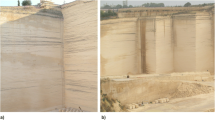Abstract
Accurate modeling of hydraulic properties such as transmissivity and interbed specific storages is significant for reliable predictions of land subsidence modeling. Calibration of land subsidence model is a challenge because of the strong non-linearity of groundwater flow equation especially when it accounting for the interbed drainage process. Pumping well drawdown and land subsidence data are very important signals for identification of aquifer hydraulic properties. In this work, it is proposed that the ensemble Kalman filter is used to calibrate the transmissivity and interbed elastic and inelastic specific storages using both drawdown and subsidence data for the first time. A synthetic example demonstrated that the characterization of transmissivity and specific storages is improved, and the uncertainties of predictions of both drawdown and subsidence are reduced, when additional dynamic observation data are used for inverse modeling. Issues such as how to account for interferometric synthetic aperture radar data, which may be encountered using the EnKF for real case studies, are discussed.





Similar content being viewed by others
References
Burbey T, Zhang M (2015) Inverse modeling using PS-INSAR for improved calibration of hydraulic parameters and prediction of future subsidence for Las Vegas Valley, USA. Proc Int Assoc Hydrol Sci 372:411
Burbey TJ (2006) Three-dimensional deformation and strain induced by municipal pumping, part 2: numerical analysis. J Hydrol 330(3):422–434
Burgers G, van Leeuwen P, Evensen G (1998) Analysis scheme in the ensemble Kalman filter. Mon Weather Rev 126:1719–1724
Chen Y, Zhang D (2006) Data assimilation for transient flow in geologic formations via ensemble Kalman filter. Adv Water Resour 29(8):1107–1122
Evensen G (2003) The ensemble Kalman filter: theoretical formulation and practical implementation. Ocean Dyn 53(4):343–367
Galloway DL, Burbey TJ (2011) Review: regional land subsidence accompanying groundwater extraction. Hydrol J 19(8):1459–1486
Gharamti M, Hoteit I (2014) Complex step-based low-rank extended kalman filtering for state-parameter estimation in subsurface transport models. J Hydrol 509:588–600
Gómez-Hernández J, Franssen H-JH, Sahuquillo A (2003) Stochastic conditional inverse modeling of subsurface mass transport: a brief review and the self-calibrating method. Stoch Env Res Risk Assess 17(5):319–328
Gómez-Hernández JJ, Journel AG (1993) Joint sequential simulation of multi-Gaussian fields. In: Geostatistics Troia92. Springer, pp 85–94
Halford K, Laczniak R, Galloway D (2005) Hydraulic characterization of over pressured tuffs in central Yucca flat. US Geological Survey Scientific Investigations Report 5211, Nevada Test Site, Nye County, Nevada, p 36
Hendricks Franssen H, Kinzelbach W (2008) Real-time groundwater flow modeling with the Ensemble Kalman Filter: joint estimation of states and parameters and the filter inbreeding problem. Water Resour Res 44(9):W09408
Hoffmann J, Galloway DL, Zebker HA (2003a) Inverse modeling of interbed storage parameters using land subsidence observations, Antelope Valley, California. Water Resour Res 39(2). doi:doi:10.1029/2001WR001252
Hoffmann J, Leake S, Galloway D, Wilson AM (2003b) Modflow-2000 ground-water model-user guide to the subsidence and aquifer-system compaction (sub) package. Technical Report, DTIC Document
Houtekamer PL, Mitchell HL (2001) A sequential ensemble Kalman filter for atmospheric data assimilation. Mon Weather Rev 129(1):123–137
Johnson AI, Moston R, Morris DA (1968) Physical and hydrologic properties of water-bearing deposits in subsiding areas in central California. Technical Report
Jones CE, An K, Blom RG, Kent JD, Ivins ER, Bekaert D (2016) Anthropogenic and geologic influences on subsidence in the vicinity of New Orleans, Louisiana. J Geophys Res Solid Earth 121(5):3867–3887
Kurtz W, Hendricks Franssen H-J, Kaiser H-P, Vereecken H (2014) Joint assimilation of piezometric heads and groundwater temperatures for improved modeling of river-aquifer interactions. Water Resour Res 50(2):1665–1688
Li L, Srinivasan S, Zhou H, Gomez-Hernandez JJ (2015) Two-point or multiple-point statistics? A comparison between the ensemble Kalman filtering and the ensemble pattern matching inverse methods. Adv Water Resour 86:297–310
Li L, Zhou H, Gómez-Hernández JJ, Franssen H-JH (2012) Jointly mapping hydraulic conductivity and porosity by assimilating concentration data via ensemble Kalman filter. J Hydrol 428:152–169
National Research Council (1991) Mitigating losses from land subsidence in the United States. National Academies Press
Panzeri M, Riva M, Guadagnini A, Neuman SP (2015) Enkf coupled with groundwater flow moment equations applied to Lauswiesen aquifer, Germany. J Hydrol 521:205–216
Pavelko MT (2004) Estimates of hydraulic properties from a one-dimensional numerical model of vertical aquifer-system deformation, Lorenzi Site, Las Vegas. Nevada. US Department of the Interior, US Geological Survey
Poeter EP, Hill M C (1998) Documentation of UCODE, a computer code for universal inverse modeling. DIANE Publishing, Denver, Colorado
Riley FS (1969) Analysis of borehole extensometer data from central California. Land Subsid 2:423–431
Wen XH, Chen W (2005) Real-time reservoir model updating using ensemble Kalman filter. In: SPE reservoir simulation symposium
Yan T, Burbey TJ (2008) The value of subsidence data in ground water model calibration. Ground Water 46(4):538–550
Zhang M, Burbey TJ, Nunes VDS, Borggaard J (2014) A new zonation algorithm with parameter estimation using hydraulic head and subsidence observations. Groundwater 52(4):514–524
Zhou H, Gómez-Hernández JJ, Li L (2014) Inverse methods in hydrogeology: evolution and recent trends. Adv Water Resour 63:22–37
Acknowledgements
The first author acknowledges the financial support by South Dakota School of Mines and Technology through Nelson Research Grant. The authors also wish to thank the editor as well as two anonymous reviewers for their comments, which substantially helped improving the final version of the manuscript.
Author information
Authors and Affiliations
Corresponding author
Rights and permissions
About this article
Cite this article
Li, L., Zhang, M. Inverse modeling of interbed parameters and transmissivity using land subsidence and drawdown data. Stoch Environ Res Risk Assess 32, 921–930 (2018). https://doi.org/10.1007/s00477-017-1396-x
Published:
Issue Date:
DOI: https://doi.org/10.1007/s00477-017-1396-x




